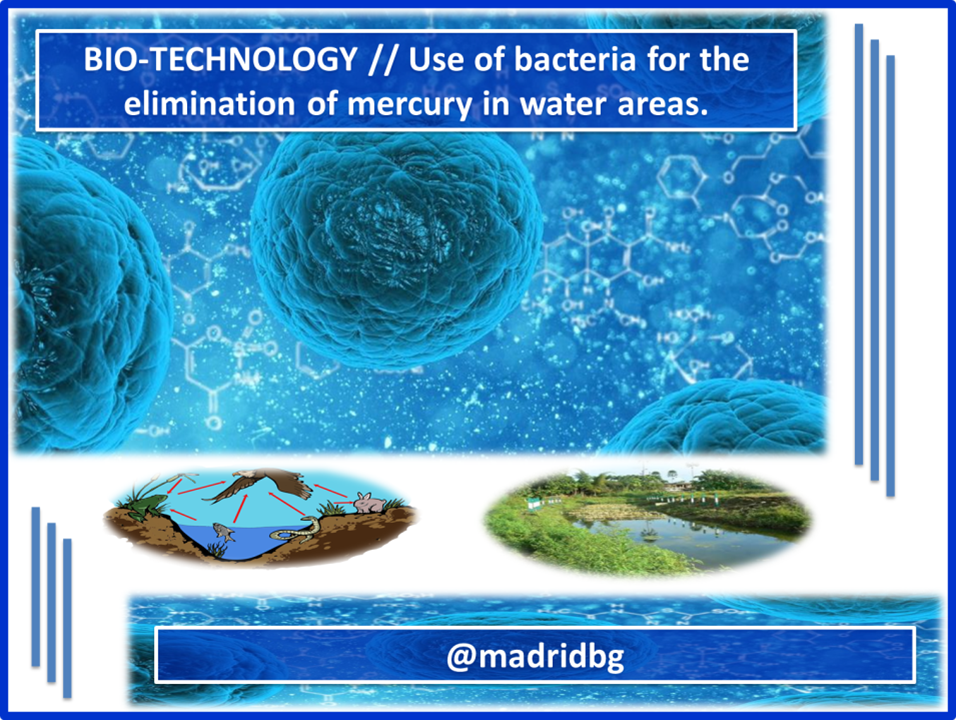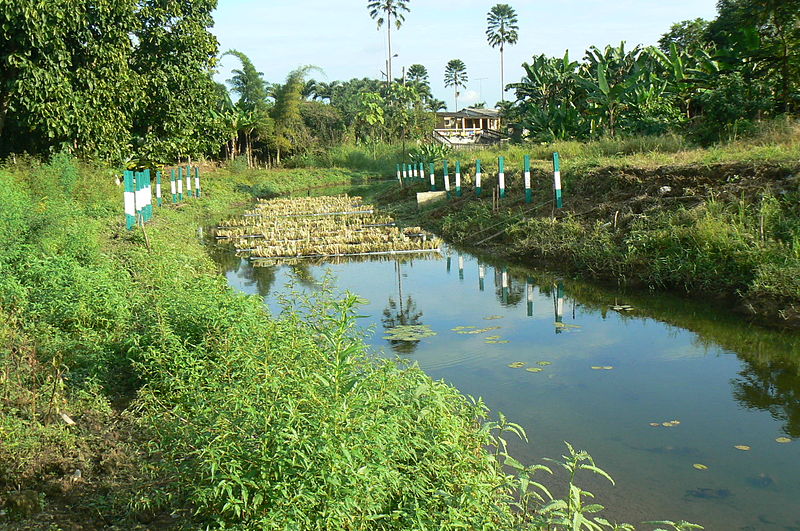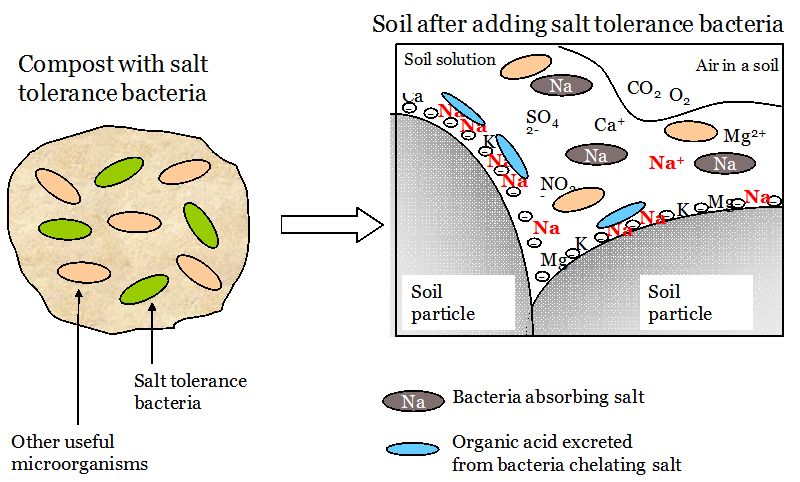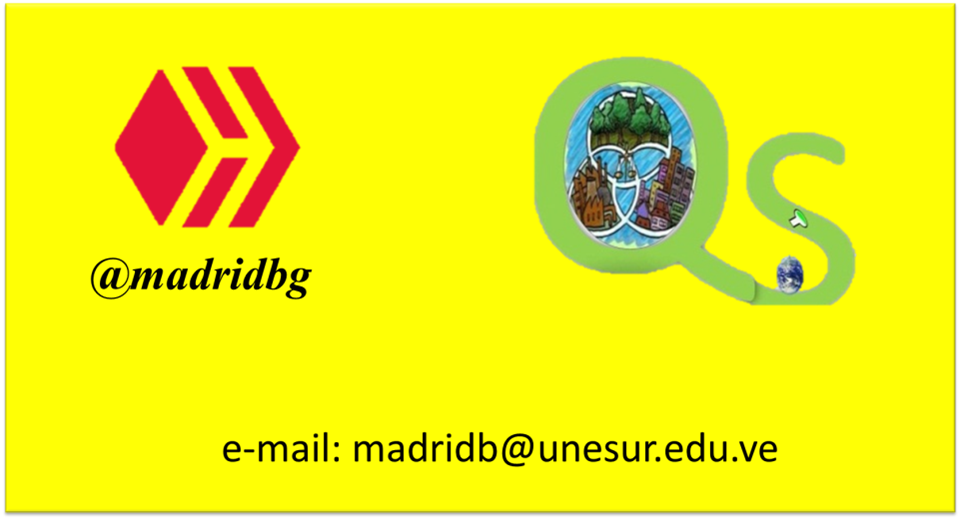BIO-TECHNOLOGY // Use of bacteria for the elimination of mercury in water areas.
(Edited)

Author: @madridbg, through Power Point 2010, using public domain images.
Greetings to my dear members of this prestigious chain of blocks, especially those who make life in the community @project.hope and who are passionate about contents of scientific, technological, economic, psychological interest, among others. The present delivery serves to continue sharing with you the technological contributions that have set the trend in favor of welfare and environmental care.
In this opportunity we will be addressing the use of bacteria as a measure to reduce the levels of mercury contamination in coastal waters or near industrial centers. Sediments play a crucial role in aquatic ecosystems due to the amounts of nutrients they provide to the species that inhabit coastal waters.

Fig. 2. The bio-remediation process seeks to remove heavy metal concentrations from wastewater and coastal areas Author:Wikyhelper
In recent years, as a result of industrial processes, these sediments have been loaded with highly toxic and contaminating materials, among which mercury (Hg) stands out thanks to the mobility that this metal can present.

Fig. 3. Heavy metals such as mercury exhibit mobility through the food chain. Author:Raquelarellanoleo
In this sense, after research in the biotechnological field carried out at the Institute of Marine Sciences (ICM-CSIC), a bio-remediation process has been developed through the use of detoxifying bacteria, in charge of restoring the environmental alterations caused by the metal, which is directed by the researcher Silvia Acinas.
In Bravo Andrea's opinion, she is an active researcher of the process:
"Mercury is a contaminant that can end up in marine sediments and can be transferred and bioaccumulated. For this reason, reducing mercury levels in sediments through bio-remediation is the basis for restoring contaminated environments".
Therefore, it is of utmost importance to make known this type of initiative, where to make the process more efficient, different types of research are being undertaken, oriented to the cultivation of microorganisms, the use of special cells with microbial functions and everything from the sediment itself, which has allowed a fundamental and isotopic analysis of the concentrations of mercury that technological progress has managed to extract from the water tributaries.

Fig. 4. Representation of a bio-remediation process. Author: By M. Azizul Moqsud and K. Omine
In my opinion, the scientific and technological advances have allowed the development of measures to combat environmental problems that have arisen from different approaches to knowledge, which is why there is a need to socialize this type of topic.
Therefore, I would like to know your opinion about it and you can express it in the commentary session, see you in the next delivery.
BIBLIOGRAPHY CONSULTED
[1] Oliart, R. Manresa, Á. Sánchez M. (2016). Utilization of microorganisms from extreme environments and their products in biotechnological development. Biotecnología y Ciencias Agropecuarias ISSN 2007-7521. 11(1): 79-90.
Article: Online Access
OF INTEREST
•

Grateful with the community @project.hope and with all the management team of the same one that they motivate us to continue working in a mutual and balanced growth.


0
0
0.000
https://twitter.com/BGMadrid/status/1346552571448717313
#posh twitter
https://twitter.com/BGMadrid/status/1346552571448717313?s=20
Very interesting and important information. Thanks for sharing!
Posted Using LeoFinance Beta
Hello @hiveapprentice thanks for your valuable comment, it's nice to know that you liked the socialized information.
Whether or not this is new biotechnology, I believe that in my country to the south of Venezuela this would be of great use, above all because of the contamination that exists in those rivers.
@tipu curate 3
Upvoted 👌 (Mana: 0/78) Liquid rewards.
Hello @lanzjoseg firstly thank you for your comment. Undoubtedly it is a great alternative that we can replicate in different areas of our country, for example in the process of eutrophication of Lake Maracaibo where industrial discharges have been so large that has generated negative effects on the species that live there.
Greetings friend @madridbg
This potential is one of the least exploited to address environmental problems related to mercury pollution, but paradoxically it is the most friendly.
Hello dear Professor @lupafilotaxia.
The bacterial use correlated with the technological advances are a powerful alternative to mitigate part of the damage that the big industrial processes have produced on the aquatic ecosystems. Thank you for leaving your comment
@ecotrain and @artemislives might be interested in reading about this fascinating technology. Thank you for this article. I wrote one regarding the impact of mercury on the environment and, at the time, I didn't even know something like this existed.
Hello @scholaris thanks for your comment, it's nice to know that the information shared has been of your interest, I will take your suggestion into account. Greetings
Hello friend, it is a great advance, the environment deserves much from us, thanks to it we can live in this world and we must give all our support to keep it as stable and clean as possible. I believe that it is a subject that not everything is taken into consideration, it makes a lot of education about it. Greetings!
Greetings @franyeligonzalez thank you for stopping by and leaving your comment.
The environmental issue should be a priority for humanity in general, I consider that there are many technological advances in favor of ecological welfare, however there is still much to do to mitigate the imbalance that we have managed to produce as a society.
This is a fascinating concept. I recently learned about the application of fungi and mushrooms to similar problems.
Hello @rasbas the implementation of microorganisms and algae for environmental care is a fascinating and creative idea to mitigate the environmental damage we have caused. Thank you for stopping by and leaving your comment.
I agree. And of course with the urgency that we need to address these issues, we have to continue to think in creative ways. There are also projects where micro-organisms eat plastic as well.